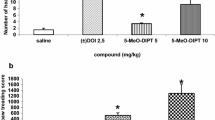Abstract
Awake Sprague-Dawley rats were depleted of brain serotonin (5HT) by intraventricular injections of 50 μg 5,7-dihydroxytryptamine (5,7-DHT) through chronically implanted cannulae. Oral pretreatment with 25 mg/kg desmethylimipramine was used to protect brain noradrenergic neurons from 5,7-DHT. In a separate set of animals, liquid chromatographic assays revealed that this treatment did not significantly alter catecholamine levels but depleted hippocampal 5HT by 80–90% and caudate 5HT by 30–42% as early as 24 h after administration of 5,7-DHT. One or 3 days after lesioning, locomotor and exploratory behavior was characterized with a Behavioral Pattern Monitor (BPM). Relative to controls, lesioned rats exhibited a decreased rate of habituation of both locomotor activity and investigatory holepokes. Although the amount of locomotor activity elicited by amphetamine (1.0 mg/kg) was unchanged by the 5HT depletion, lesioned animals exhibited highly stereotyped patterns of locomotion during the last 30-min test session, in contrast to the relatively random patterns characteristic of control animals given amphetamine. These results show that central serotonergic pathways play an important role in modulating both spontaneous and amphetamine-elicited activity in rats.
Similar content being viewed by others
References
Adams LM, Geyer MA (1982) LSD-induced alteration of locomotor patterns and exploration in rats. Psychopharmacology 77:179–185
Baumgarten HG, Klemm HP, Sievers J, Schlossberger HG (1982) Dihydroxytryptamines as tools to study the neurobiology of serotonin. Brain Res Bull 9:131–150
Brody JF (1970) Behavioral effects of serotonin depletions and of p-chlorophenylalanine (a serotonin depletor) in rats. Psychopharmacologia 17:14–33
Deakin JF, File SE, Hyde JR, Macleod NK (1979) Ascending 5-HT pathways and behavioral habituation. Pharmacol, Biochem Behav 10:687–694
Fibiger HC, Campbell BA (1971) The effects of para-chlorophenylalanine on spontaneous locomotor activity in the rat. Neuropharmacology 10:25–32
Flicker C, Geyer MA (1982) Behavior during hippocampal micro-infusions: I. Norepinephrine and diversive exploration. Brain Res Rev 4:79–103
Geyer MA (1978) Heterogenous functions of discrete serotonergic pathways in brain. In: Usdin E, Mandell AJ (eds) New vistas in the biochemistry of mental disorders. Marcel Dekker, New York, pp 233–260
Geyer MA, Puerto DB, Menkes DB, Segal DS, Mandell AJ (1976) Behavioral studies following lesions of mesolimbic and mesostriatal serotonergic pathways. Brain Res 106:257–270
Geyer MA, Petersen LR, Rose GJ (1980) Effects of serotonergic lesions on investigatory responding by rats in a holeboard. Behav Neural Biol 30:160–177
Geyer MA (1982) Variational and probabilistic aspects of exploratory behavior in space: Four stimulant styles. Psychopharmacol Bull 18:48–51
Geyer MA, Lee EHY (1984) Effects of clonidine, piperoxane, and locus coeruleus lesion on the serotonergic and dopaminergic systems in raphe and caudate nucleus. Biochem Pharmacol 33:3399–3404
Geyer MA, Gordon J, Adams LM (1984) Depletions of central norepinephrine by intraventricular xylamine in rats. Eur J Pharmacol 100:227–231
Hole K, Fuxe K, Jonsson G (1976) Behavioral effects of 5,7-dihydroxytryptamine lesions of ascending 5-hydroxytryptamine pathways. Brain Res 107:385–399
Hole K, Jonsson GE, Berge OG (1977) 5,7-dihydroxytryptamine lesions of ascending pathways: habituation, motor activity and agonistic behavior. Pharmacol Biochem Behav 7:205–210
Hollister AS, Breese GR, Kuhn C, Cooper BR, Schanberg SM (1976) An inhibitory role for brain serotonin-containing systems in the locomotor effects of d-amphetamine. J Pharmacol Exp Ther 198:12–22
Jacobs BL, Wise WD, Taylor KM (1974) Differential behavioral and neurochemical effects following lesions of the dorsal or median raphe nuclei in rat. Brain Res 79:353–361
Jonsson G, Hallman H, Ponzio F, Ross S (1981) DSP4 (N-(2-chloroethyl)-N-ethyl-2-bromobenzylamine)-A useful denervation tool for central and peripheral noradrenaline neurons. Eur J Pharmacol 72:173–188
Konig JRF, Klippel RA (1963) The rat brain: a stereotaxic atlas of the forebrain and lower parts of the brain stem. Baltimore: Williams and Wilkins
Lat J (1969) The spontaneous exploratory reactions as tools for psychopharmacological studies. A contribution towards a theory of contradictory results in psychopharmacology. In: Mikhelson MY, Longo VG, Votava Z (eds) Pharmacology of conditioning, learning, and retention. Pergamon Press, Oxford, pp 47–66
Lorens SA (1978) Some behavioral effects of serotonin depletion depend on method: A comparison of 5,7-dihydroxytryptamine, p-chlorophenylalanine, p-chloroamphetamine, and electrolytic raphe lesions. Ann NY Acad Sci 305:532–555
Marsden CA, Curzon G (1979) Effects of p-chlorophenylalanine and α-methyltryptophan on behavior and brain 5-hydroxyindoles. Neuropharmacology 16:489–494
McCall RB, Aghajanian GK (1979) Denervation supersensitivity to serotonin in the facial nucleus. Neuroscience 4:1501–1510
Miller FP, Cox RH, Snodgrass WR, Maikel RP (1970) Comparative effects of P-chlorophenylalanine, P-chloramphetamine and P-chloro-N-methylamphetamine on rat brain norepinephrine, serotonin and 5-hydroxyindole-3-acetic acid. Biochem Pharmacol 19:435–442
Neill DB, Grant LD, Grossman SP (1972) Selective potentiation of locomotor effects of amphetamine by midbrain raphe lesions. Physiol Behav 9:655–657
Schiorring E (1979) An open field study of stereotyped locomotor activity in amphetamine-treated rats. Psychopharmacology 66:281–287
Segal DS (1976) Differential effects of para-chlorphenylalanine on amphetamine-induced locomotion and stereotypy. Brain Res 116:267–277
Segal DS, Geyer MA, Shuckit MA (1981) Stimulant-induced psychosis: an evaluation of animal models. In: Youdim MBH, Lovenberg W, Sharman DF, Lagnado JR (eds) Essays in neurochemistry and neuropharmacology, Vol 5. John Wiley and Sons, Ltd., New York
Srebro B, Lorens SA (1975) Behavioral effects of selective midbrain raphe lesions in the rat. Brain Res 89:303–325
Stewart RM, Growdon JH, Cancian D, Baldessarini RJ (1976) 5-hydroxytryptophan-induced myoclonus: Increased sensitivity to serotonin after intracranial 5,7-dihydroxytryptamine in the adult rat. Neuropharmacology 15:449–455
Wirtshafter D, Asin KE, Kent EW (1980) An analysis of open field hyperactivity following electrolytic median raphe lesions in the rat. Soc Neurosci 6:422
Author information
Authors and Affiliations
Rights and permissions
About this article
Cite this article
Gately, P.F., Poon, S.L., Segal, D.S. et al. Depletion of brain serotonin by 5,7-dihydroxytryptamine alters the response to amphetamine and the habituation of locomotor activity in rats. Psychopharmacology 87, 400–405 (1985). https://doi.org/10.1007/BF00432502
Received:
Accepted:
Issue Date:
DOI: https://doi.org/10.1007/BF00432502



